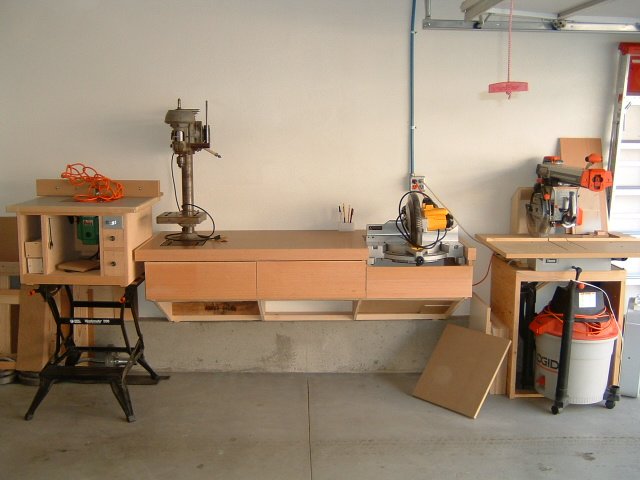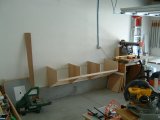|
The goal of this project was to permanently mount several "fixed" tools in a minimal amount of space. An accessible area under the workbench was a secondary objective. I like the flexibility of an open floor for cleaning and storage. The basic design and construction details were borrowed from Norm Abrams Garage Workshop Episode I tweaked his design to fit my needs. I adopted a modular approach for the design, this allows the project to scale up to any size. Each section is 24" wide, additional sections can be added easily for a larger project. Many of the dimensions and measurement on this project size are vague, I care to capture all of that information, many parts of the project were sized on my environment. |
 Click picture for larger image |
|
This picture shows the first
stage of the project. It is 3 modules in
size, each module is 24" wide on center. The height and width were
determined by my available space. My final width was 29" from the edge
of the workbench to the wall. In the picture you can see a continuous
concrete footing. The footing has a 4" ledge that I am resting the
workbench
on. I set the height close to the height of my table saw, my floor
slopes down so the table height varies.
For my application I wanted to have plenty of room underneath the bench so I cut the shape into something of a triangle. In order to maximize the use of material I kept the width of the frames to 23 9/16". This allowed me to get more material out of a 4 x 8 sheet of plywood. Here is a cutting diagram that illustrates what I am talking about. |
|
|
The installation was fairly
simple up to this point. I used a strip of plywood (painted white in
the picture) to hold the frames in place in the back. The ends were
connected with butt joints and the center rows were notched for the
strip. I secured the center units from the back with screws. The bottom
and front rails are 2 x 4's that are installed with butt joints. The
center pieces are secured with toe nailed screws. The front 2 x 4 was
also ripped at an angle to fit flush. I assemble the unit on the floor
and then I secured it to studs in the wall. If you lack a concrete
footing you could install a 2 x 4 to the wall first. Just make sure you
secure it to studs.
|
 Click picture for larger image |
|
In the next step I borrowed a
page right out of Norm,s book.
I extended the length of the panels by adding an extra piece. This step
is only necessary if you want to minimize waste. In the cutting
diagram you can see where the pieces came from. The extensions were
secured with glue and pocket screws. This is purely an optional
step. The entire piece could have been cut from plywood, or the
additional length might not be necessary. I wanted my workbench to have
at least 28'" in depth.
This seemed like the most economical way to achieve it.
You might notice that I mounted my chop saw in the frame. I figured it was easier to mount it now before final assembly. There were 2 considerations for mounting the saw. The first one was the height. I wanted the deck of the saw to be flush with the workbench. I made a mock up "sandwich" of the top to help me determine where to mount the cleats for the saw. I set the sandwich on the divider to see how high I needed to mount the saw. The other consideration was the relative position to the radial arm saw fence. I planned on adding a space for the radial arm saw and I wanted the fences to line up exactly. |
|
|
The next step was also borrowed
from Norm, surprised? I began
to fabricate
the top out of half lapped 2 x 4's.
The 2 x 4's rest on the frame, I
used 2 x 2's around the chop saw. You might notice a piece of plywood
on the left side. That will support a drill press. I wanted to make the
base of the drill press flush with the top, this enables me to work
with long stock the workbench using the radial arm saw or the chop saw.
The plywood sits in a dado in the 2 x 4's and is secured with drywall screws and glue. The dado was necessary to get a perfectly flush fit with the top. I also installed t-nuts in the plywood to secure the drill press when it is installed. |
|
|
I jumped the gun a bit while
working on this next part. This picture show a couple of steps. I
neglected to mention that before I installed the 2x4 half lapped frame
above, I used it as a template to cut out a piece of plywood and
hardboard for the top. This photo also include the installation
of the drill press and the completed installation of rails.
I had pre-measured the depth of the drill press using my "sandwich." By setting the drill press on the ground next to my sandwich I measured the height of the sandwich above the drill press deck. Next I cut a dado of the same distance around the bottom of the 2 x 4's supporting the drill press. Once I installed the plywood I had a perfect fit. The second step I left out was cutting out the space for the drill press. I simply set the drill press down on the top before it was installed, traced it out and then made my cut with a jig saw. Finally I installed all of my full extension slides. These slides were salvaged from a computer room. If you look closely you can see that the slides under the drill press wrap around the plywood frames. I had to chisel those ears off the other drawer so they did not overlap. |
|
|
This picture shows the drawers installed, but it provides no details on there construction. Each drawer is assembled with pocket screws. A dado on the sides of the drawer supports a 1/2" bottom. The assembly was tricky because the rails I am using are for computers not furniture. They do not detach at all. I had to fully extend the rails and then hold the drawer in place to attach it. The best advice I can give you if you want to try this yourself is to grow a third arm. |
|
|
This picture shows little except
for the "finish" I wrapped the work bench in redwood. The main reason
for this is when I went to the lumberyard this is just about the only
stock I could buy that was wide enough to cover the drawers without a
glue up. I covered the edges of the work bench, and the drawer fronts,
including a false drawer under the chop saw.
|
Click picture for larger
image
|
|
|
Click picture for larger
image
|